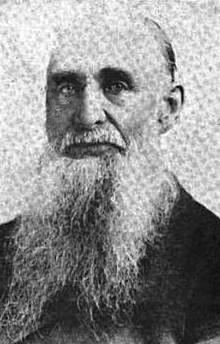By Doris
George Goddard, an early convert to The Church of Jesus Christ of Latter-day Saints (often misnamed the “Mormon Church”) was rejected by his relatives in England after he was baptized. George and his wife and seven children journeyed to the western Zion by land and sea. Four of the children died along the way.
 Establishing themselves in the Salt Lake Valley, George became a prominent business and Church leader, serving with the presiding bishopric, serving in the presidency of the Sunday Schools of the Church (with President George Q. Cannon and the other counselor, Karl G. Maeser), singing in the Tabernacle Choir for fifteen years, and being called by Brigham Young to serve as secretary to the school of the prophets in Salt Lake City.
Establishing themselves in the Salt Lake Valley, George became a prominent business and Church leader, serving with the presiding bishopric, serving in the presidency of the Sunday Schools of the Church (with President George Q. Cannon and the other counselor, Karl G. Maeser), singing in the Tabernacle Choir for fifteen years, and being called by Brigham Young to serve as secretary to the school of the prophets in Salt Lake City.
During the early 1860s the pioneering Saints needed more paper to advance the causes of education and publishing. Paper was made from rags for several years, but even rags were difficult to come by because the people had scarcely enough to cover their bodies. Brigham Young called successful businessman George Goddard on a “Rag Mission,” going door to door throughout the territory “for the purpose of gathering up whatever might be obtained convertible into printing paper.”1 As a true Englishman, George wrote, “[This calling] was a severe blow to my native pride. . . . After being known in the community for years, as a merchant . . . then to be seen on the streets going from door to door with a basket on one arm and an empty sack on the other, enquiring for rags at every house. Oh, what a change in the aspect of affairs. . . . When President Young first made the proposition, the humiliating prospect almost stunned me, but a few moments’ reflection reminded me that I came to these valleys of the mountains . . . for the purpose of doing the will of my Heavenly Father, my time and means must be at His disposal. I therefore answered President Young in the affirmative, and for over three years, from Franklin, Idaho, in the north, and Sanpete in the south, my labors extended, not only visiting many hundreds of houses during the week days, but preaching rag sermons on Sunday. The first time I ever spoke in the Tabernacle, Salt Lake City, was a rag discourse, and Presidents Brigham Young and Heber C. Kimball backed it up with their testimony and enlarged upon it.”2
“It was my duty as a servant of God to obey, and as such I undertook it, to assist in laying the foundation of an important home enterprise. . . . No person could have been more abundantly blessed of the Lord than I was during the three years I was thus engaged. The Spirit of the Lord made me cheerful and happy, and the feeling of humiliation was removed.”3
This was a “riches to rags” story, in a sense, but George’s humble service provided over 100,000 pounds of rags for the paper mills. Not only that, but he “became so well known to the Saints in the territory that following his mission his business flourished and his popularity as a merchant was even greater than before.”4
George Goddard concluded this episode of his life by testifying: “I can truly say that the Lord inspired me with His Holy Spirit to deliver rag sermons, as much as if I was preaching upon . . . any other principle of the gospel. . . . [Jesus] descended below all things that He might be exalted above all things. And he that humbleth himself shall be exalted. Therefore, let no one feel that by responding to the calls of the Priesthood, however humiliating the duty imposed may be to natural pride, the luster of their respectability will not be dimmed or their usefulness curtailed thereby. Let us stoop to conquer.”5
Many Latter-day Saints have been asked to sacrifice a great deal to build up the kingdom of God on the earth, and most of the time they heed the call. Men like George Goddard were fortunately not scarce at critical times in the Church’s history, and the inspired others Saints then as well as today to step up and make the sacrifices that God requires of them.
Read D. Kelly Ogden’s full article, “What More Can We Do? A Rags to Riches Story”
Sources:
1 Deseret News, May 14, 1862.
2 Deseret Weekly, April 4, 1896, 485; as cited in Leonard J. Arrington, Great Basin Kingdom, Cambridge, Mass.: Harvard University Press, 1958, 115.
3 George Goddard, “Review of an Active Life,” in The Juvenile Instructor, 1882, 174.
4 Church News View point, August 3, 1996, 16.
5 George Goddard, “Review of an Active Life,” in The Juvenile Instructor, 1882, 174.
About Keith L. Brown
Keith L. Brown is a convert to The Church of Jesus Christ of Latter-day Saints, having been born and raised Baptist. He was studying to be a Baptist minister at the time of his conversion to the LDS faith. He was baptized on 10 March 1998 in Reykjavik, Iceland while serving on active duty in the United States Navy in Keflavic, Iceland. He currently serves as the First Assistant to the High Priest Group for the Annapolis, Maryland Ward. He is a 30-year honorably retired United States Navy Veteran.

 Watch a video about the restoration of the gospel on lds.org
Watch a video about the restoration of the gospel on lds.org